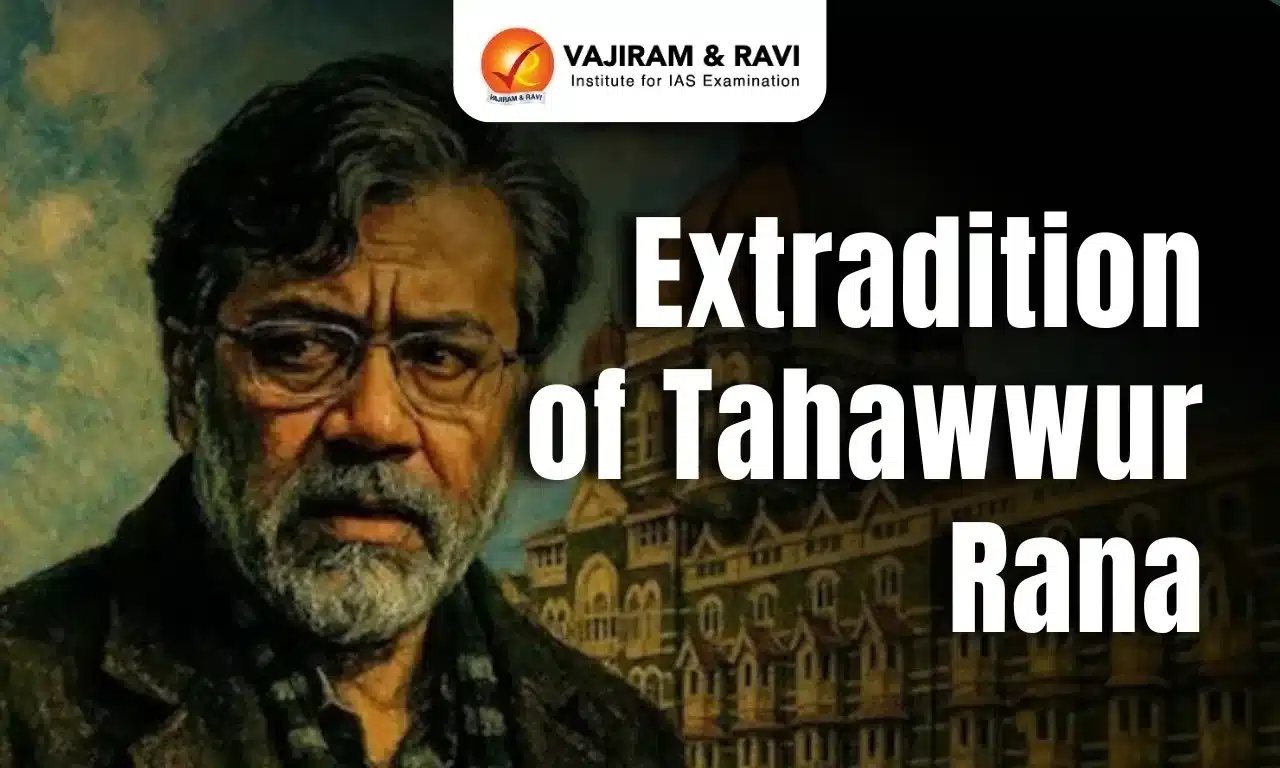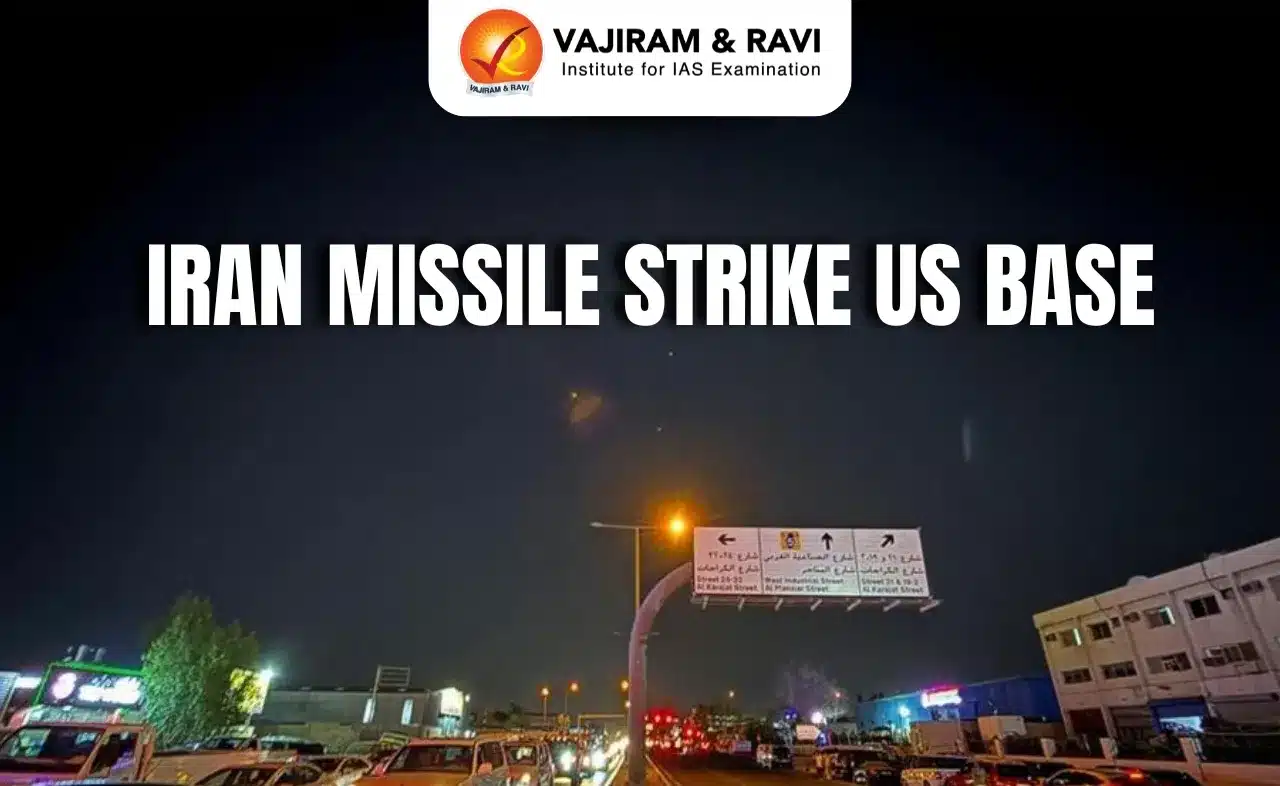What’s in Today’s Article?
- Extradition of Tahawwur Rana Latest News
- Background – Key Details of 26/11 Mumbai Terror Attacks
- About Tahawwur Rana
- Legal Proceedings and Extradition Journey
- Political and Diplomatic Significance
- About Extradition
- Challenges in Extradition Process
- Extradition of Tahawwur Rana FAQs
Extradition of Tahawwur Rana Latest News
- More than 16 years after the 2008 Mumbai terror attacks, key conspirator Tahawwur Rana has been extradited to India from the United States.
- His arrival marks a major milestone in India’s counterterrorism efforts and showcases the efficacy of sustained diplomatic, legal, and intelligence cooperation between India and the US.
Background – Key Details of 26/11 Mumbai Terror Attacks
- Date: November 26–29, 2008.
- Casualties: 166 killed, over 238 injured.
- Perpetrators: 10 Pakistani terrorists affiliated with Lashkar-e-Taiba (LeT).
- Targeted sites: CST railway station, Taj Mahal Hotel, Oberoi Trident, and Nariman House (Jewish Centre).
- Modus operandi: Infiltration via sea route from Pakistan.
About Tahawwur Rana
- Nationality: Pakistani-born Canadian citizen.
- Background: Former officer in Pakistan Army Medical Corps.
- Association: Close associate of David Coleman Headley (aka Daood Gilani), key Lashkar-e-Taiba scout.
- Arrested: In Chicago, October 2009.
- Role in 26/11:
- Logistical support: Facilitated planning and coordination of attacks.
- Affiliations: Linked to LeT and Harkat-ul-Jihadi Islami (HUJI) – both banned under India’s Unlawful Activities (Prevention) Act, 1967.
Legal Proceedings and Extradition Journey
- Key milestones:
- US Magistrate Court approves extradition; accepts India’s argument (led by Sr. Advocate Dayan Krishnan) refuting the double jeopardy defense.
- Later, the US Supreme Court denied relief, dismissing the review plea, and finalizing extradition.
- Role of legal and security agencies:
- Lead counsel (India): Dayan Krishnan (Senior Advocate).
- Prosecution team: Narender Mann, Sanjeevi Sheshadri, Sridhar Kale, NIA legal team.
- Security escort: NSG and NIA officials; special aircraft used for transfer from Los Angeles.
- Current status:
- Formally arrested at IGI Airport, New Delhi.
- Produced before NIA Special Court, Patiala House.
- Remanded to 18 days of NIA custody.
Political and Diplomatic Significance
- India-US cooperation:
- Extradition treaty basis: India-US Extradition Treaty.
- Key support: US Department of Justice, Sky Marshal, and Indian intelligence.
- Diplomatic coordination: MEA, MHA, NIA, and Indian Embassy in the US.
- Political reactions: PM Modi thanked the US for supporting India’s justice system.
About Extradition
- Definition: Formal process where one country surrenders an individual to another country for prosecution or punishment.
- Key principles:
- Treaty-based: Usually requires a bilateral or multilateral treaty.
- Dual criminality: Offence must be punishable in both jurisdictions.
- Exceptions: Political offences, lack of good faith, etc.
- India’s extradition framework:
- Extradition treaties: With 48 countries.
- Extradition arrangements (non-binding): With 12 countries.
- Governing agency: Ministry of External Affairs (MEA).
Challenges in Extradition Process
- Lengthy legal procedures: Rana’s case took over a decade to conclude.
- Political sensitivities: Extradition often depends on diplomatic relations.
- Contrast with Headley case: David Headley’s plea deal in the US prevents extradition; serving a 35-year sentence there.
Extradition of Tahawwur Rana FAQs
Q1. What is the significance of Tahawwur Rana’s extradition for India’s counter-terrorism efforts?
Ans. Rana’s extradition marks a major diplomatic and legal breakthrough, showcasing India’s sustained efforts against global terrorism.
Q2. Explain the role of dual criminality in extradition treaties using the Rana case as context.
Ans. The principle of dual criminality, where the crime must be punishable in both jurisdictions, was crucial in the US court’s approval of Rana’s extradition to India under the India-US Extradition Treaty.
Q3. Who represented the Indian government in the legal proceedings related to Rana’s extradition and what was the crux of their argument?
Ans. Senior advocate Dayan Krishnan led India’s case, arguing successfully that Rana’s extradition did not amount to double jeopardy, thereby satisfying US legal standards.
Q4. Highlight the institutional coordination involved in securing Rana’s extradition to India.
Ans. The extradition involved coordination between the NIA, Ministry of External Affairs, Ministry of Home Affairs, US Department of Justice, and Indian intelligence agencies, reflecting multi-agency diplomatic synergy.
Q5. What does the delay in Rana’s extradition indicate about the nature of international legal cooperation?
Ans. The over-a-decade-long delay underscores the complexity, political sensitivity, and procedural challenges inherent in international extradition cases, even between treaty partners.
Last updated on June, 2025
→ UPSC Notification 2025 was released on 22nd January 2025.
→ UPSC Prelims Result 2025 is out now for the CSE held on 25 May 2025.
→ UPSC Prelims Question Paper 2025 and Unofficial Prelims Answer Key 2025 are available now.
→ UPSC Calendar 2026 is released on 15th May, 2025.
→ The UPSC Vacancy 2025 were released 1129, out of which 979 were for UPSC CSE and remaining 150 are for UPSC IFoS.
→ UPSC Mains 2025 will be conducted on 22nd August 2025.
→ UPSC Prelims 2026 will be conducted on 24th May, 2026 & UPSC Mains 2026 will be conducted on 21st August 2026.
→ The UPSC Selection Process is of 3 stages-Prelims, Mains and Interview.
→ UPSC Result 2024 is released with latest UPSC Marksheet 2024. Check Now!
→ UPSC Toppers List 2024 is released now. Shakti Dubey is UPSC AIR 1 2024 Topper.
→ Also check Best IAS Coaching in Delhi
























